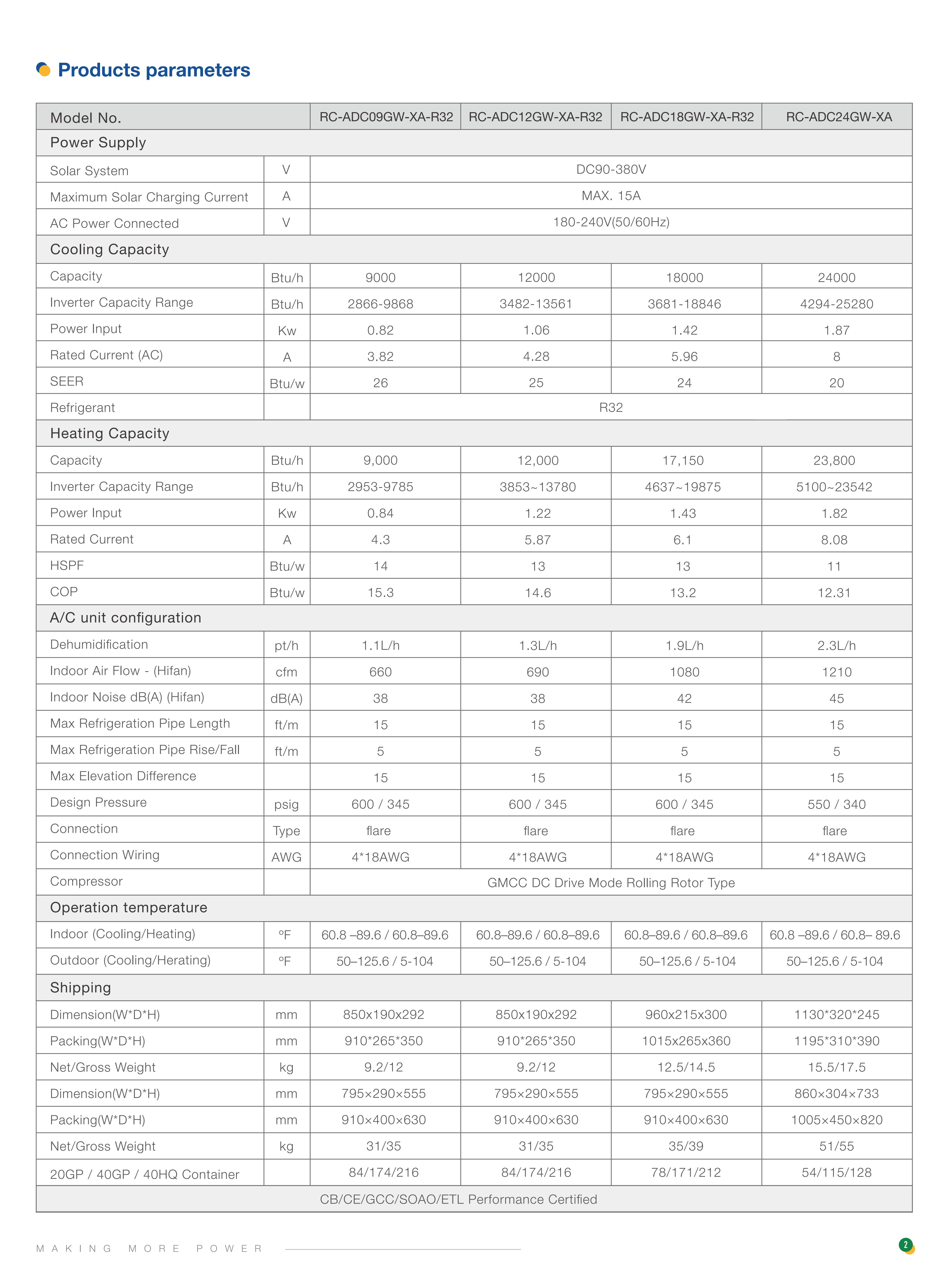R32 and R410A are both commonly used refrigerants in air conditioning systems. However, there are some differences between the two, particularly in terms of environmental impact and energy efficiency.
Solar panel voltage:
DC90-380VMaximum Solar Charging Current:
15AAC Power Connected:
180-240V(50/60Hz)Refrigerant:
R32Compressor:
GMCC DC Drive Mode Rolling Rotor TypeConnection:
Flare
An off-grid solar air conditioner is a cooling system that operates independently of the traditional electrical grid. It utilizes solar energy as the primary power source instead of relying on electricity from the grid. The system typically consists of photovoltaic (PV) solar panels, a battery bank for energy storage, and an inverter to convert the DC power from the solar into AC power required by the air conditioner.
Off-grid solar air conditioners are especially useful in remote areas or locations where access to electricity is limited or unreliable. They offer the advantage of being environmentally friendly by using renewable solar energy, reducing dependence on fossil fuels and minimizing carbon emissions.
These systems generally require careful planning to ensure that the solar panels provide enough power to run the air conditioner efficiently. battery bank serves as a storage solution, allowing the system to operate during periods of low or no sunlight. Sizing the solar panels and battery bank properly is crucial to ensure that the conditioner can run consistently without running out of power.
It's worth noting that off-grid solar air conditioning systems can be more expensive upfront compared to conventional grid-connected air conditioners. However, they offer long-term savings by reducing or eliminating electricity costs. Additionally, they provide energy independence and the ability to cool spaces in areas without access to traditional power sources.

R410A and R32 are both commonly used refrigerants in air conditioning systems. Here's a comparison between the two:
Composition: R410A is a blend of two hydrofluorocarbon (HFC) refrigerants, namely difluoromethane (R32) and pentafluoroethane (R125), in a 50:50 ratio by weight. On the other hand, R32 is a single-component refrigerant consisting solely of difluoromethane.
Global Warming Potential (GWP): GWP is a measure of the greenhouse gas potential of a substance compared to carbon dioxide. R410A has a relatively high GWP of 2,088, while R32 has a lower GWP of 675. This means that R32 has a lower impact on global warming potential compared to R410A.
Efficiency: R32 has better thermodynamic properties than R410A, leading to improved energy. Air conditioning systems using R32 as the refrigerant can achieve higher Coefficient of Performance (COP), meaning they provide better cooling performance per unit of energy consumed.
4.: Both R410A and R32 are considered safe for use in air conditioning systems when handled properly. However, R32 is classified as slightly flammable, while R410A is non-flammable. Due to R32's flammability, installation, maintenance, and handling of R32-based systems require specific safety precautions and compliance with regulations.
Transition: Many manufacturers have been transitioning from R410A to R32 due to its lower GWP and higher energy efficiency. R32 is gradually becoming a more popular choice for new air conditioning systems and heat pumps.

A small solar-powered air conditioner can work well to keep an attic cool and dry. The unit sits on a shingle roof, just as an attic vent might. These small systems can be purchased (and easily self-installed) for under $500. For larger systems, however, the cost of a solar air conditioning unit varies widely, depending on the type and size of the unit and how much space you want to cool.
For a 24-hour hybrid system, a direct current (DC) 12,000-BTU cooling unit sold by HotSpot Energy can cost up to $2,000, not including solar panels. Six solar panels capable of running the cooling unit can cost up to $1,600. Hybrid systems also rely on AC grid power when solar power is not available, so they need AC/DC inverters as well. Add in inverters, controllers, and mounting hardware, and the cost of a total system can be over $6,000. Similar hybrid systems are also available from SolarAir World International and by regional or local installers.
FAQs:
Q1: Do you support OEM/ODM?
A:Definitely, OEM&ODM service is supported with a certain quantity,including customize logo,package and label;
Q2: What's the production time?
A: The production time is normally 15 working days. but we will always prepare some stocks for popular models.
Q3: Can you provide DDP service?
A:Yes, if you are a personal customer and don't want to deal with the customs, we can provide DDP service to your address.
Q4: What about the warranty and how to claim?
A: Warranty period are 5 years since you receive the product, our professional after-sales team will deal with all warranty issues.